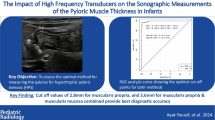Abstract
Purpose
To retrospectively review imaging planes, number of visible pyloric layers and location of measurements, in infants with suspected (HPS).
Methods
103 pyloric ultrasound studies for suspected HPS were included. For each study, we recorded whether longitudinal or transverse views were performed, the layers visualized (a schematic was developed for two pediatric radiologists to categorize the interfaces of the anatomic layers a–e) and position of the internal measurement cursor. Categories for the anterior (superficial wall) layers were from external to internal: (a) internal aspect of the muscularis propria; (b) external aspect of the muscularis mucosa; (c) internal aspect of the muscularis mucosa; (d) internal aspect of the mucosa interfacing with a mucosal fold (e) deep aspect of the mucosal fold. Median differences between HPS groups were calculated and inter-reader agreement (kappa score) was performed between both readers.
Results
In 100 studies (97 patients), longitudinal (99%) and transverse (69%) views of the pylorus were recorded. For longitudinal views, measurements included muscle thickness (95%), length (97%) and no pyloric diameter. For the transverse view, measurements included muscle thickness (16%) and the diameter (3%). Pyloric layer interfaces were visible: (a) in 64% (b) in 64% (c) in 66% (d) in 30% and (e) in 26%. The internal reference point of cursor placement for measuring the muscle wall thickness in the longitudinal view for one reader was as follows: (a) 46% (b) 27% (c) 30% (d) 1% and (e) 2% of studies. Surgically proven HPS group had a median thickness measurement 0.17 mm greater than the non-HPS studies (CI 95% 0.12–0.21, p < 0.05), and inter-reader agreement was considered as moderate (Kappa 0.5).
Conclusions
We found a variety of thickness measurements performed predominantly in the longitudinal view and a largely abandoned diameter measurement. The latter might offer a solution as it is not defined by any internal interfaces.







Similar content being viewed by others
References
Hernanz-Schulman M, Sells LL, Ambrosino MM, Heller RM, Stein SM, Neblett WW 3rd (1994) Hypertrophic pyloric stenosis in the infant without a palpable olive: accuracy of sonographic diagnosis. Radiology 193(3):771–776. https://doi.org/10.1148/radiology.193.3.7972822
O'Keeffe FN, Stansberry SD, Swischuk LE, Hayden CK Jr (1991) Antropyloric muscle thickness at US in infants: what is normal? Radiology 178(3):827–830. https://doi.org/10.1148/radiology.178.3.1994426
Hallam D, Hansen B, Bodker B, Klintorp S, Pedersen JF (1995) Pyloric size in normal infants and in infants suspected of having hypertrophic pyloric stenosis. Acta Radiol (Stockholm, Sweden: 1987) 36(3):261–264
Rohrschneider WK, Mittnacht H, Darge K, Troger J (1998) Pyloric muscle in asymptomatic infants: sonographic evaluation and discrimination from idiopathic hypertrophic pyloric stenosis. Pediatr Radiol 28(6):429–434. https://doi.org/10.1007/s002470050377
Kofoed PE, Host A, Elle B, Larsen C (1988) Hypertrophic pyloric stenosis: determination of muscle dimensions by ultrasound. Br J Radiol 61(721):19–20. https://doi.org/10.1259/0007-1285-61-721-19
Niedzielski J, Kobielski A, Sokal J, Krakos M (2011) Accuracy of sonographic criteria in the decision for surgical treatment in infantile hypertrophic pyloric stenosis. Arch Med Sci AMS 7(3):508–511. https://doi.org/10.5114/aoms.2011.23419
Sivitz AB, Tejani C, Cohen SG (2013) Evaluation of hypertrophic pyloric stenosis by pediatric emergency physician sonography. Acad Emerg Med 20(7):646–651. https://doi.org/10.1111/acem.12163
Hernanz-Schulman M (2009) Pyloric stenosis: role of imaging. Pediatr Radiol 39(Suppl 2):S134–139. https://doi.org/10.1007/s00247-008-1106-4
Lowe LH, Banks WJ, Shyr Y (1999) Pyloric ratio: efficacy in the diagnosis of hypertrophic pyloric stenosis. J Ultras Med 18(11):773–777
Westra SJ, de Groot CJ, Smits NJ, Staalman CR (1989) Hypertrophic pyloric stenosis: use of the pyloric volume measurement in early US diagnosis. Radiology 172(3):615–619. https://doi.org/10.1148/radiology.172.3.2672088
Cielma TKR, RDCS, RVT, RT(S), Bandarkar ANM, Adeyiga AOM (2017) A sonographic walk-through: infantile hypertrophic pyloric stenosis. The World Federation of Pediatric Imaging. Accessed 31 Mar 2019
Hernanz-Schulman M (2003) Infantile hypertrophic pyloric stenosis. Radiology 227(2):319–331. https://doi.org/10.1148/radiol.2272011329
Breaux CW Jr, Georgeson KE, Royal SA, Curnow AJ (1988) Changing patterns in the diagnosis of hypertrophic pyloric stenosis. Pediatrics 81(2):213–217
Godbole P, Sprigg A, Dickson JA, Lin PC (1996) Ultrasound compared with clinical examination in infantile hypertrophic pyloric stenosis. Arch Dis Child 75(4):335–337
Funding
No financial grants were use in this study.
Author information
Authors and Affiliations
Corresponding author
Ethics declarations
Conflicts of interest
Authors declare no conflict.
Ethical standards
This study was IRB approved by our committee, following the HIPPAA regulations.
Additional information
Publisher's Note
Springer Nature remains neutral with regard to jurisdictional claims in published maps and institutional affiliations.
Rights and permissions
About this article
Cite this article
Calle-Toro, J.S., Kaplan, S.L. & Andronikou, S. Are we performing ultrasound measurements of the wall thickness in hypertrophic pyloric stenosis studies the same way?. Pediatr Surg Int 36, 399–405 (2020). https://doi.org/10.1007/s00383-019-04601-2
Accepted:
Published:
Issue Date:
DOI: https://doi.org/10.1007/s00383-019-04601-2




